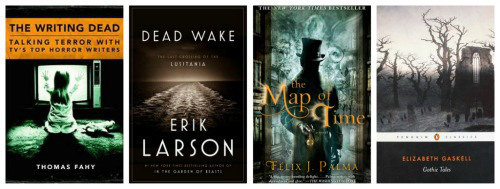Katherine Nabity's Blog, page 195
February 3, 2015
Deal Me In Lunar Extra ~ “The Belated Burial”
Hosted by Jay @ Bibliophilopolis
I was very indecisive when picking my Deal Me in Stories, so I added an extra ���Lunar��� twist.
For each full moon, I���ll be reading a horror story written by a woman.
“The Belated Burial” by Caitl��n R. Kiernan
Card picked: A Seven
From: Available online from Subterranean Press
Thoughts: I’d venture to say that to some extent everyone has a fear of being buried alive, but the premature burial hysteria of the late 1700s and 1800s took the matter to an extreme level. Edgar Allan Poe had a fascination with the subject and many of his works involve the trope. Caitlin Kiernan’s “The Belated Burial” takes the concept and flips it on its side.
Brylee has been undead for nearly a month. Tradition states that the young vampire must be given a funeral and buried, if only for a day and a night. Brylee knows that no harm can come to her in the black lacquered pine box, buried in the frozen winter earth, but that doesn’t mean she doesn’t fear the experience. Her mistress, Miss Josephine, assures her that the experience is necessary and that “there is always something incalculably worse than the very worst thing that she can imagine.” Which is a comforting thought, isn’t it?
Kiernan borrows from another work of Poe, his poem “The Conqueror Worm,” to illustrate just what a vampire might have to fear.
Previously: Caitlin Kiernan is a name I’m familiar with, but this might be the first story of hers I’ve read. Just today, I notice that she has a story included in the upcoming Year���s Best Weird Fiction, Volume 2.
I found this story through Paula Cappa’s Women in Horror Month 2014. Women in Horror month is February, so check out Paula’s blog for this year’s great bunch of authors!

February 2, 2015
Pinned: February Reading List
The Writing Dead by Thomas Fahy – ARC
Dead Wake by�� Erik Larson – ARC
The Map of Time by Felix Palma
Python for Informatics by Charles Severance – Programming for Everybody!
“God Sees the Truth, but Waits” by Leo Tolstoy – Week 6 DMI
“The Belated Burial” by Caitlin Kiernan – Lunar DMI
“The Old Nurse���s Story” by Elizabeth Gaskell – Gothic Reading Challenge
The Sphinx, February 1905, Volume 3, no. 12

What Else In January
Writing Work
 Eric read through In Need of Luck and we’ve worked out yet more of the plot. Now, I just need to buckle down and write it.
Eric read through In Need of Luck and we’ve worked out yet more of the plot. Now, I just need to buckle down and write it.
Eric’s been reading science fiction and, when Eric reads science fiction, we end up having many discussions about science. Some of his thoughts on Andy Weir’s The Martian found their way on his blog and into ebook form. I spent a good week of January formatting The Martian Engineer’s Notebook, Volume 1 and puzzling through Draft2Digital and the wonders of ebook formatting using Calibre.��The Martian Engineer’s Notebook is available for free at all the major places, like Amazon.
What Else Did I Read
Some short story highlights:
“Cat Pictures Please” by Naomi Kritzer
When a search engine algorithm gains consciousness, it decides to be quietly beneficial to humans. (Quietly, because it’s seen our science fiction movies…) All it would like in return is more cat pictures on the internet. This is a sweet, funny tale of an AI undergoing a career crisis.
“Paladin of the Lost Hour” By Harlan Ellison
Someone was looking for short story recommendations on Reddit and this is my go-to suggestion. I was just surprised that it was available online at Ellison Webderland. Ellison is very vocal about (not) giving away fiction. It’s one of my favorite stories, ever.
“The Vanishing Man” by Allen Upward
“The Vanishing Man”�� was originally published in 1904 in The Royal Magazine. I learned of its existence while reading a 1905 issue of The Sphinx, a magazine for magicians. Isn’t it funny that it was probably easier for me, 115 years later, to read about “The Vanishing Man” in The Sphinx and then track down a copy than it probably was for a reader in 1905? I love the world I live in. It’s not a very good story. The premise is that Sir Forrester Hervey is a professional guest. He gets paid to go to parties, to fill in. In this case, a mistake sends him to fill in for a magician meant to entertain at a children’s party. Hilarity ensues, especially since Hervey decides that the bullet catch is a good amateur trick.
Other Life Stuff
Suffered with a pretty nasty cold for the first week of January. When it hit the “coughing while I’m trying to sleep” phase, I decided to buy some NyQuil. Now, I’ve really never used NyQuil before. I’m more of an AlkaSeltzer Cold/generic cough syrup kinda gal. Turns out, NyQuil and I don’t get along. I ended up fainting a couple of times which was a little scary.
Ended up being a pretty busy month in VOTS-land, though I didn’t end up playing as much as I would have liked. I had signed up for women’s winter league, but only played one game out of four. Granted, our last one (this past week) was rained out. Speaking of rain, for the second time in three years, New Year Fest (our local big tournament) was rained out. This is after a 30 year run of beautiful weather for it. I had decided I wasn’t going to play, but I was looking forward to helping out and watching a few games. On the plus side,�� I wasn’t totally worn out on Sunday for Super Bowl festivities.
Spring league starts this week after a pretty quick setup and draft. Our field situation wasn’t ideal which led to some delays. But we’re up and going.

February 1, 2015
Deal Me In, Week 5 ~ “The Cloak”
Hosted by Jay @ Bibliophilopolis
“The Cloak” by Nikolay Gogol
Card picked: The Four of Hearts
From: Great Russian Stories, selected by Isai Kamen. I own this as a 1960s Vintage paperback that I’m fairly sure I picked up out of a freebie bin in downtown Lincoln.
Thoughts:
Poor Akaki Akakiyevich. He’s a low-level cog in the Russian bureaucracy machine. He’s paid little and is not respected by his co-workers even though he does his job very well. He’s just plodding through life, generally minding his own business, until his cloak wears out.
[image error]At first, getting a new cloak is a major hassle. He has to deal with his drunken tailor neighbor *and* the tailor’s wife. A major pain for a social inept. And it’s going to cost a small fortune; Akaki Akakiyevich is just an “official” working in a “department.” But as Akaki Akakiyevich saves up for it, denying himself everything he can, even going hungry, he let’s himself dream about the new cloak. How nice and warm it will be. How fashionable. He gets rather excited by the prospect and is very pleased by the garment once it’s made and paid for. For Akaki Akakiyevich, it’s the nicest thing he’s ever owned.
It becomes pretty obvious that among his peers, Akaki Akakiyevich is still pretty shabby. He’s still bottom rung. But, not quite.�� Still below him on the social scale are the bearded men who waylay him on the way back from a coworker’s fancy party and steal his cloak. No one with any measure of power within the bureaucracy is willing to help Akaki Akakiyevich and he dies.
This might be a story about the dangers of overreaching position (how dare an official in a department yearn for something beyond his cabbage soup!), but Gogol has an epilogue. For a while a ghost haunts the streets of St. Petersburg, snatching off the cloaks of officials and Prominent Personages alike…
Published in 1842, “The Cloak” (or “The Greatcloak” or “The Overcoat,” depending on translation), this story is very linear and takes a while to get where it’s going, though Gogol’s narrative fourth-wall-breaking embellishments struck me as funny.
As we have mentioned his wife, it will be necessary to say a word or two about her.
As a note: Much is made about the St. Petersburg weather in this story. A guy I knew from St. Petersburg gave up smoking the winter he lived in Lincoln, Nebraska because the wind was too damn cold to be standing outside smoking in it.
Previously: I haven’t read much/any Gogol previously. This story in particular seems to be considered a linchpin of Russian literature, even though there is some controversy because Gogol was *gasp* born in the Ukraine. It will be interesting to see if Gogol’s wry humor is carried on by some of the later authors on my list.

January 29, 2015
Review ~ Sleights of Mind
Stephen Macknik and Susana Martinez-Conde, the founders of the exciting new discipline of neuromagic, have convinced some of the world’s greatest magicians to allow scientists to study their techniques for tricking the brain. This book is the result of the authors’ yearlong, world-wide exploration of magic and how its principles apply to our behavior. Magic tricks fool us because humans have hardwired processes of attention and awareness that are hackable���a good magician uses your mind’s own intrinsic properties against you in a form of mental jujitsu.
Now magic can reveal how our brains work in everyday situations. For instance, if you’ve ever bought an expensive item you’d sworn you’d never buy, the salesperson was probably a master at creating the “illusion of choice,” a core technique of magic. The implications of neuromagic go beyond illuminating our behavior; early research points to new approaches for everything from the diagnosis of autism to marketing techniques and education. Sleights of Mind makes neuroscience fun and accessible by unveiling the key connections between magic and the mind (via Goodreads)
I checked this out from the library at the same time as Will Storr’s The Unpersuadables. Without really planning it, these two books are interesting companions, covering similar (and sometimes the same) issues of perception and deception. Although the more recently published of the two, Storr’s book seemed to have the older science. Or maybe it was that his reaction to the science felt strangely outdated. A lot of Sleights of Mind wasn’t new to me. I’ve been poking around in the theories of magic for a few years now and even attended a lecture event at ASU back in 2012 with Stephen Macknik and Susana Martinez-Conde and magicians Jamy Ian Swiss and Joshua Jay. When Storr was surprised and appalled by how much our brain infers and how our memories are terribly malleable, I was was kinda saying to myself, “Well, yeah.”*
Sleights of Mind assumes all the mind’s confabulations are a given and endeavors to better understand the processes by looking at how magicians manipulate their audience.
By understanding how magicians hack our brains, we can better understand how the same cognitive tricks are working in advertising strategies, business negotiations, and all varieties of interpersonal relations. When we understand how magic works in the mind of the spectator, we will have unveiled the neural bases of consciousness itself.
Which is a pretty lofty goal and one that the authors are still pursuing.
Sleights of Mind and The Unpersuadables also have journey in common. Will Storr travels the globe investigating beliefs of all kinds. Macknik and Martinez-Conde travel to magic conventions and visit with world renowned illusionists. All involved are looking for answers. What I like about Sleights of Mind is its optimism. Some of the tricks our brain plays are really extraordinary and lead to good things like our sense of wonder. Understanding is only ever a good thing.
I do think that Macknik and Martinez-Conde give magicians a little too much credit for actually knowing what they’re doing on more than an intuition/tradition level. This is an example of the difference between what science does and what can result from technological advancement without scientific method. Magicians have come upon their techniques through a process of using what works, passing it on to the next generation of magicians who might tweek the methods, but rarely innovate through scientific method (observation, hypothesis, experimentation, re-evaluation). This isn’t to say that there aren’t some texts out there by magicians that look at the nitty gritty, but it’s rare. Learning what works has traditionally superseded *why* something works.
The book exposes many magic tricks. It’s hard to discuss why magic works without talking about how its done. Macknik and Martinez-Conde have become members of the major magic guilds in existence, which includes performing for a board of professionals at the Magic Castle in Hollywood. Each exposure is marked with a spoiler warning because most of the injunction against letting laypeople know secrets is to avoid inadvertent exposure. This book is really only for people who aren’t going to be disappointed to find out the nuts and bolts of magic.
* One of the things that did catch my interest was the McGurk effect. This is a sort of weird perceptual misfire that can occur when what we see and what we hear differ. It’s easier to link to a video than explain it:
Except this illusion didn’t work for me. Some other videos that I surfed to did, but results were mixed. Which got me to wondering, is it my face-blindness? Is it my left-of-center placement on the autism spectrum?
Publishing info, my copy: Henry Holt and Company, 2010, Hardback
Acquired: Tempe Public Library
Genre: Non-fiction, Magic and Related Subjects
Previously: Susana Martinez-Conde was an occasional guest lecturer in one of the classes my husband Eric took for his Computational Bioscience masters. He even got to play with brains at the Barrow Institute… And as I said above we also attended a panel discussion at ASU. It’s on YouTube!

January 26, 2015
Magic Monday ~ The Sphinx, January 1905
I like Mondays. On Monday, I am refreshed from the weekend and exhilarated by the possibilities of the week ahead. I also like magic. I like its history, its intersection with technology, and its crafty use of human nature.�� I figured I’d combine the two and make a Monday feature that is truly me: a little bit of magic and a look at the week ahead.
I decided sometime during the first week of January to read through some back issues of The Sphinx, the magazine that served as the news and method-sharing publication for the Society of American Magicians from 1902 to 1953. It wasn’t always unanimously accepted. Houdini himself started a rival publication in 1906, but it didn’t last long. I was going to do a monthly summary, but decided it would probably be too long of a post and only really interesting to me. Instead, I’ll share a tid-bit or two.
 On the /r/magic sub-reddit, someone asked about tricks that involve guns. Other than in the bullet catch, guns don’t get used much anymore, for obvious reasons. This didn’t used to be the case. The gun was a common prop for a good long while and used for trivial reasons. In a write-up about Horace Goldin’s program, Henry Whiteley describes when Goldin “takes silk handkerchief, vanishes it and produces from behind leg; places it on end of gun, fires, handkerchief vanished and reproduced from coat collar.” Shooting handkerchiefs, common everyday occurrence. Goldin goes on to innovate the sawing-in-halves illusion in the 1920s.
On the /r/magic sub-reddit, someone asked about tricks that involve guns. Other than in the bullet catch, guns don’t get used much anymore, for obvious reasons. This didn’t used to be the case. The gun was a common prop for a good long while and used for trivial reasons. In a write-up about Horace Goldin’s program, Henry Whiteley describes when Goldin “takes silk handkerchief, vanishes it and produces from behind leg; places it on end of gun, fires, handkerchief vanished and reproduced from coat collar.” Shooting handkerchiefs, common everyday occurrence. Goldin goes on to innovate the sawing-in-halves illusion in the 1920s.
What Am I Reading?
I started reading The Magician’s Daughter by Judith Janeway last week, but I couldn’t get into it. After waffling, I picked up The Map of Time by Felix J. Palma. I think I’m going to be working on it for a while. I should finish my current non-fiction read, The Writing Dead, this week. I drew “The Greatcoat” by Nikolay Gogol for Deal Me In, and maybe I’ll be a schooly and read ahead for the Coursera class that starts next week. I’m setting my sights on officially learning my first programming language, Python.
What Am I Writing?
Spent a good portion of last week getting Eric’s latest project formatted and into circulation. This week, I need to get back to what I said I was going to be doing last week. I also realized that I know nothing about prisoner transport, was making things up, and I need to rewrite an earlier scene.
On the Blog
Review of The Hound of the Baskervilles
Deal Me In
And “What Else in January” that will include a few of my favorite non-DMI short stories of the month.
I also need to remember that I’m going to be mostly AFK on for the weekend and should write those last two posts before Saturday.

January 24, 2015
Deal Me In, Week 4 ~ “Private Grave 9″
Hosted by Jay @ Bibliophilopolis
“Private Grave 9″��by Karen Joy Fowler
Card picked: Jack of Spades
From: McSweeney’s Mammoth Treasury of Thrilling Tales, ed. by Michael Chabon
Thoughts: Archeological digs. In recent years, they’ve been at the center of action-paced adventure tales, like The Mummy and Raiders of the Lost Arc. Slightly closer to reality, the heyday of archeological expeditions boasted of curses and blood-thirsty tomb robbers.�� But my first Thrilling Tale is kind of a quiet one.
As Howard Carter is making headlines uncovering Tutankhamun’s tomb in Egypt in 1923, our unnamed narrator is a photographer at an “also ran” dig in Mesopotamia. Not long ago the tomb of a princess and her servants, and subtle clay shards depicting dogs and goats would have been enough to appease the dig’s patron, but not with brick-a-brac of gold and lapis being unearthed elsewhere. And don’t mention the entire level of infant skeletons that were also unearthed…
Our skeletons are too numerous to be tasteful.
Despite this, a distant relation of the dig’s director visits. Miss Whitfield is “an authoress” with five successful murder mysteries to her name. She is also a disruptive force, a pot-stirrer. She’s looking for dissent among the peaceful dig-site hierarchy. “But if you did murder someone,” she innocently asks, “would it be Mr. David or Mr. Patwin?”
Co-currently, our photographer develops a picture of Princess Tu-api which appears (to him) to show her face as it might have been in life. Is it Tu-api who is inspiring his discontent and violent visions or the evocative Miss Whitfield?
About the Author: I’ll admit it. Even as I wish that the boundary between “literary” and “genre” fiction didn’t exist, I suffer from a sort of cognitive dissonance when authors I’ve pegged as literary (Joyce Carol Oates, for example) write a genre story or vice versa. The first read story I read by Karen Joy Fowler was the Nebula award winning “What I Didn’t See.” It’s maybe light on the fantastic, but the association is enough to place her in my genre heap. That she also wrote��The Jane Austen Book Club completely befuddles me. I read Fowler’s�� “The Queen of Hearts and Swords” during week ten of Deal Me In 2014.
Is This Your Card?
The Jack of Spades has an early cameo.

January 23, 2015
Write On Review-a-Thon 12
The Write On review-a-thon is a monthly event created and hosted by Brianna at The Book Vixen. This time, for the FIRST TIME ever, it���s 3 days dedicated to getting reviews done, whether you have one review to write or 30+. This edition of the review-a-thon takes place all day Friday, January 23rd through Sunday, January 25th. Let���s get those reviews done!
To-Do List:
“Private Grave 9″ by Karen Joy Fowler for Deal Me In
The Two Sams by Glen Hirshberg
Sleights of Mind by Macknik, Martinez-Conde, & Sandra Blakeslee
The Hound of the Baskervilles by Arthur Conan Doyle
January Short Fiction post
The Sphinx, January 1905
Magicienne Monday setup (Not really a review but something I was intending to get done a month ago.)
Glad this review-a-thon is three days long. This is a mighty backlog for me!

January 22, 2015
Review ~ The Castle of Otranto
On the day of his wedding, Conrad, heir to the house of Otranto, is killed in mysterious circumstances. Fearing the end of his dynasty, his father, Manfred, determines to marry Conrad’s betrothed, Isabella, until a series of supernatural events stands in his way. . . .
Set in the time of the crusades, The Castle of Otranto established the Gothic as a literary form in England. With its compelling blend of psychological realism and supernatural terror, guilty secrets and unlawful desires, it has influenced a literary tradition stretching from Ann Radcliffe and Bram Stoker to Daphne Du Maurier and Stephen King. (via Goodreads)
Goodreads blurbs are interesting. Sometimes spoilery, sometimes off-base. For example, in the case of The Castle of Otranto, I would not stick the label of “psychological realism” on it. Granted, published in 1764 near the beginning of the novel as a literary form, Otranto has characters who are at least meant to be characters rather than pawns of allegory and satire. But psychologically accurate? Not so much.
I like this Goodreads blurb better:
One of the first, great Gothic novels, and one of the most influential books in literary history, this thrilling tale abounds in adventure, suspense, and supernatural occurrences. In a realm where a villain reigns, mysterious events aid in fulfilling a prophecy that spells doom for the ruler and justice for the rightful heir.
One of the most influential books in literary history? I think there’s a strong argument for *that*. Gothic fiction became the flip-side to Romanticism. Instead of��bucolic scenery and love, peace and harmony, gothic novels are full of dark forests, brooding castles, and lustful, scheming villains. But that comes later. For Walpole, this seems to be his reaction to the picaresque and epistolary novels that existed. Wikipedia notes that Walpole was admittedly influenced by Shakespeare. I can see this mashup of moral, travel-based adventure literature and the darker, supernatural aspects of Shakespeare.
Stylistically, The Castle of Otranto sets up so many tropes of gothic fiction. The castle and abbey with secret tunnels. The sinister landscape surrounding Castle Otranto. The lecherous villain and the imperiled women. Secret lineages. Walpole even sets up the narrative within a narrative, claiming that the tale of Castle Otranto is a translation of an Italian manuscript from the 1200s which is in fact a story from the 1000s. I don’t know if Walpole is the first to do this, but it’s certainly a reoccurring aspect of gothic fiction.
Story-wise? Well, it was published in 1764. It alternates between a bit zany and a bit dry.�� Honestly, even though it was 100 pages long, it felt like it should have been half that. There are some genuinely creepy bits set amid some eye-rolling dialogue. And some of the twists? It could be argued (and probably is somewhere) that the modern soap opera is based on gothic literature.
Publishing info, my copy: Public Domain Kindle edition, transcribed from the 1901 Cassell and Company edition
Acquired: Amazon
Genre: Gothic!
Previously: This is the first Walpole I read that I know of. Obviously, not the first Gothic fiction.
Recently, I made a statement that Eleanor, in Shirley Jackson’s The Haunting of Hill House, *wishes* she were in a gothic novel, but isn’t. I’ll stick to that considering that��Hill House has many gothic aspects (the house, the tale of Hugh Crain and his progeny), but follows a different path. The Seance by John Harwood is more gothic than I realized when I tagged it as such. Lastly, I’m going to revisit, in the near future, Steven Wedel’s article “Horror’s Hearth and Home: The Use of Setting in American Gothic Fiction”.
See Also:
Books Under the Bed’s Gothic Reading Challenge post on Otranto
The Castle of Otranto: The creepy tale that launched gothic fiction @ BBC.com

January 19, 2015
Magic Monday ~ Zig-Zag Girl
I like Mondays. On Monday, I am refreshed from the weekend and exhilarated by the possibilities of the week ahead. I also like magic. I like its history, its intersection with technology, and its crafty use of human nature.�� I figured I’d combine the two and make a Monday feature that is truly me: a little bit of magic and a look at the week ahead.
Some illusions are so popular that they feel like they’ve been around forever. One such is Zig-Zag Girl. If you’ve watched a few TV magic specials in the past 50 years, you’ve seen it. In fact, I wouldn’t be surprised if television is a major contributor to its popularity. It is a very visual trick. Smaller magic gets lost on television, even in the age of high-def. Zig-Zag Girl allows for a visual prop that is isn’t overwhelmingly complex and is still interesting when shot uncut with one camera angle.
The trick was innovated by Robert Harbin in the mid-1960s. To “protect” his invention, Harbin published it in a special edition book and only sold it to fellow magicians willing to sign a sort of non-disclosure agreement. The document stated that the purchaser would not reveal the secret to anyone else and only build the apparatus for personal use. Regardless, the illusion is in the Guinness Book of World Records as one of the most copied. (via MagicPedia)
Below is Zig-Zag Girl performed by its creator, Robert Harbin, and a more modern rendition by Piff the Magic Dragon.
What Am I Reading?
 The Hound of the Baskervilles is going much slower than I expected, especially for a reread. I don’t remember the story being this long. Maybe it just seems that way since I’m reading on my Kindle from a “complete works” collection. The percentage finished number rarely moves. Next up The Magician’s Daughter by Judith Janeway and probably The Writing Dead by Thomas Fahy. Both are ARCs, the only two I have from NetGalley at the moment.
The Hound of the Baskervilles is going much slower than I expected, especially for a reread. I don’t remember the story being this long. Maybe it just seems that way since I’m reading on my Kindle from a “complete works” collection. The percentage finished number rarely moves. Next up The Magician’s Daughter by Judith Janeway and probably The Writing Dead by Thomas Fahy. Both are ARCs, the only two I have from NetGalley at the moment.
What Am I Writing?
Last week, Eric took a look at the first 43K of In Need of Luck. We’ve nailed down a few plot points which require a little rewriting in a few earlier scenes. Our process isn’t to write a fast first draft beginning to end. Instead, we continually re-evaluate what’s going on and what needs improvement. Eric’s also been writing a scientific guide to Andy Wier’s book, The Martian, and we’ll do the editing and formatting on that this week.
On the Blog
Review of The Castle of Otranto for the Gothic Reading Challenge. If I finish it by then, I might include a gothic look at The Hound of the Baskervilles.
This weekend is the Book Vixen’s monthly Review-a-thon and I have a few things that need getting done.
And, I finally get to dip into Thrilling Tales for Deal Me In.













